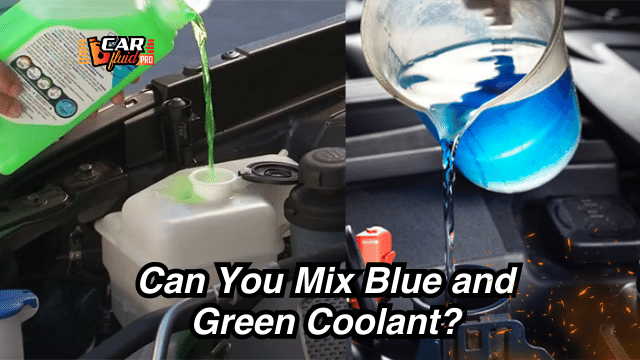Can You Mix Green and Yellow Antifreeze? (Don’t Do It)
Car antifreeze or coolants come in different colors: green, yellow, orange, blue, etc. Coolants prevent car engine overheating by keeping the motor temperature at its expected level. They need to be replaced periodically to ensure the optimum performance of your car. So, when replacing, popping up a few questions are common, are different coolants blendable? Can you mix green and yellow antifreeze?
Green and yellow coolants can’t be mixed because they are formulated differently. Mixing differently formulated antifreeze will cause more harm than good. The Green-yellow coolant mixture can block the cooling system and cause severe damage to your car engine.
I explained why green and yellow coolants couldn’t be blended. Also, reading this guide will teach you the dangers of mixing the wrong coolants and how to solve the problem.
Let’s jump right in.
What are the Uses of Green and Yellow Antifreeze?
Engine coolant system follows a normal circulating mechanism on basic principles. It controls the antifreeze and moves it throughout the coolant system where necessary.
You might have seen different-colored coolants in the market. Moreover, different-colored antifreeze doesn’t follow the same formula.
Here I will share the uses of the most common antifreeze: green and yellow coolants.
Green Antifreeze
One of the common antifreeze is an Inorganic Additive Technology. The green antifreeze is formulated following this technology. It has been used in the USA for the last 70 years. Moreover, this formula provides unsurpassed rust protection.
Distinguishing this antifreeze is straightforward for its green color. But this antifreeze type doesn’t provide long-term durability. It requires replacing every 40,000 miles or 3 years.
Identifying the cooling system leaks becomes easy due to its colors. If there are green droppings beneath your car, be sure that your antifreeze has started leaking. Check the coolant reservoir and fix the problem. Then fill the tank with green antifreeze to avoid engine overheating.
Green antifreeze is mostly used in older vehicles. Modern car models use coolant that is manufactured following newer technology.
Yellow Antifreeze
Organic components are used to formulate yellow coolant. Also, it uses an ethylene glycol-based formula, making it suitable for diesel and gasoline engines. This antifreeze type is well-known for providing year-round protection from corrosion. Moreover, it offers boiling protection up to 265 °F and freezes protection down to -34°F
Also, yellow antifreeze is considered a long-lasting coolant. It remains good for at least 5 years and more. It means it is more durable compared to green antifreeze.
One of the biggest features of yellow antifreeze is it is less poisonous to the environment. Also, handling this antifreeze is safer compared to other coolants.
This is an ideal choice for vehicles manufactured after 1995. Recognizing this coolant is also simple for its characteristic coloring. If you have a vehicle that is 10 -15 years old, using yellow antifreeze will be a deal breaker. The price is also affordable, making it worth the price.
Can You Mix Green and Yellow Antifreeze?

There are multiple opinions on whether green and yellow antifreeze can be mixed. Some believe they should not be blended since colors don’t matter. On the other hand, mixing different colored coolants must be prohibited.
I discussed this with the professional mechanic, and according to them, you can’t mix green and yellow antifreeze. If you do so mistakenly, the antifreeze mixture will drastically reduce your vehicle’s performance on the road.
Below I shared the specific reason.
Reasons Why You Can’t Mix Green and Yellow Antifreeze
The only reason is that green and yellow antifreeze are not the same type. They are manufactured following different formulas.
The green antifreeze is made using Inorganic Additive Technology. On the other hand, yellow coolant is ethylene glycol-based antifreeze. It means that both are completely different. The rule of thumb when mixing 2 different coolants is they have to be the same type. If the condition fails, they can’t be mixed. This is the prime reason why you can’t mix green and yellow antifreeze.
Mixing 2 different coolant types can cause expensive and significant damage to your car engine. The mixture can overheat the engine, and permanent damage can happen.
For this reason, always check the vehicle’s compatible engine antifreeze. Also, read the car manual to learn the coolant changing or replacement procedure.
Dangers of Mixing Green and Yellow Antifreeze
It is clear that you can’t mix green and yellow antifreeze. Mixing them can lead to expensive repairs. When mixed, they will form a thick and gel-like substance which will jam the car’s coolant system. Air coolant flow will stop completely, causing engine overheating.
Moreover, the radiator and water pump will be damaged too. The water pump temperature will increase and may malfunction. Note that the repair cost of the water pump is high.
So, mixing 2 different types of antifreeze is bad. You will experience the following issues if you mistakenly lend them.
Damaged Cylinder Head
Most vehicles’ cylinder heads are made of aluminum that can only resist excessive heat. However, if your car engine runs at high temperatures frequently, the cylinder head will warp. More dangerously, mixing 2 incompatible coolants and pouring them into the coolant system can cause engine misfires and blow the head gasket.
Broken Head Gasket
The coolant and engine oil may blend due to the failed engine head gasket. As a result, your car engine can be damaged permanently. Your vehicle will release black smoke. In this case, you will need to rebuild the engine completely. Hopefully, you know that engine rebuilding is an expensive repair. Moreover, rebuilding an engine will take time also.
Marred Hoses
When 2 improper coolant types are mixed, the liquid will start boiling and expand. As a result, pressure builds up inside the hoses. In the end, the hoses can burst and separate from the car engine or radiator. Repairing such a problem will take ample time. Also, such repairs can’t be done without the help of a professional mechanic, meaning you will have to spend thousands of bucks.
Additionally, improperly blended coolants will fail to protect the coolant system from corrosion and rust. In fact, your car’s overall performance will be reduced if you mix and use green and yellow antifreeze.
What to do if You Mix Incompatible Coolants?
If you notice that you mixed incompatible coolants and used them in your car, don’t panic, as solutions are there.
You will have to do the followings,
- Flush the coolant
- Replace it with an antifreeze that is compatible with the car’s type, brand, and mixture
Generally, the cooling systems of modern vehicles are more sensitive than before. That is why it is crucial to choose the correct antifreeze per the car manufacturer’s specifications.
By flushing the improperly mixed coolants, you can easily avoid jelly-like fluids in the coolant system. Thus, you can also prevent engine damage, saving valuable money.
Ensuring periodic maintenance is important. Inspecting the quality of the coolants periodically is important. Moreover, following the changing intervals is crucial.
What Coolant can You Mix with Green Antifreeze?
Green antifreeze is IAT (Inorganic Additive Technology) coolant. They were the first antifreeze to be used in the automotive industry.
Colors are used in antifreeze for easy identification. By looking at the colors, you can’t tell precisely which colors can be mixed.
While mixing 2 types of antifreeze, you will need to ensure they are the same type. So, green coolants can be mixed with other coolants formulated with the IAT technology. Inorganic Additive Technology coolants have either propylene glycol or ethylene glycol, typically green or blue. Therefore, you can mix blue antifreeze with green antifreeze.
These are traditional coolants and are mostly used in classic vehicles.
What Coolant can You Mix with Yellow Antifreeze?
One thing you will need to keep in mind is that antifreeze can be classified by looking at its color. So, there is no direct answer to what coolants can be mixed with yellow antifreeze.
In order to answer the question, learning the antifreeze type is necessary. Yellow coolants are ethylene glycol-based antifreeze and can be mixed with the same coolant type.
Hence, before blending other coolants with yellow antifreeze, you have to know what coolants use ethylene glycol-based formula. Generally, such coolant types come in pink and orange color. Mixing the wrong antifreeze type could cause a blockage that will wreck the cooling system and lead to significant repair bills.
Therefore, before deciding on the color, know its formula and mix it. This type delivers long-lasting service and is mostly compatible with modern vehicles.
Final Words
So, can you mix green and yellow antifreeze? No, they are different types. Blending them will not give a good result, reducing engine performance.
However, if you mistakenly mix them and use them in your car, severe damage like marred hoses, broken head gaskets, etc., happens. Repairing such problems will cost you several bucks.
Don’t mix different colored coolants until you know their types. Their formula, not colors, classifies antifreeze.
Read Also:


